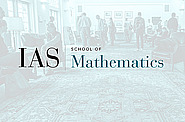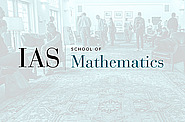Seminars Sorted by Series
Computer Science/Discrete Mathematics Seminar II
May
20
2008
May
27
2008
Computer Science/Discrete Mathematics Seminar II
Approximating Functions in Logarithmic Space and Time: A "Plug & Play" Approach
10:30am|S-101
Jun
10
2008
Computer Science/Discrete Mathematics Seminar II
Computability and Complexity of Julia sets
10:30am|S-101
Sep
09
2008
Sep
30
2008
Computer Science/Discrete Mathematics Seminar II
A Survey of Time Lower Bounds by Algorithmic Arguments
10:30am|S-101
Oct
07
2008
Computer Science/Discrete Mathematics Seminar II
Lower Bounds for Circuits with MOD_m Gates
10:30am|S-101
Oct
14
2008
Computer Science/Discrete Mathematics Seminar II
Lower Bounds for Circuits with MOD_m Gates
10:30am|S-101
Oct
21
2008
Computer Science/Discrete Mathematics Seminar II
Group Representation Patterns in Digital Processing
Shamgar Gurevich and Ronny Hadani
10:30am|S-101
Oct
28
2008
Computer Science/Discrete Mathematics Seminar II
<a href="http://focs2008.org">http://focs2008.org</a>
No Seminar Due to FOCS 2008 Symposium
10:30am
Nov
04
2008
Computer Science/Discrete Mathematics Seminar II
Dichotomy Conjecture for Constraint Satisfaction Problems
10:30am|S-101
Nov
11
2008
Computer Science/Discrete Mathematics Seminar II
Dichotomy Conjecture for Constraint Satisfaction Problems
10:30am|S-101
Nov
18
2008
Computer Science/Discrete Mathematics Seminar II
Complexity of Equational Proof Systems
10:30am|S-101
Nov
25
2008
Computer Science/Discrete Mathematics Seminar II
Complexity of Equational Proof Systems
10:30am|S-101
Dec
02
2008
Computer Science/Discrete Mathematics Seminar II
Combinatorial Reasoning in Information Theory
10:30am|S-101
Dec
09
2008
Dec
16
2008
Jan
20
2009
Computer Science/Discrete Mathematics Seminar II
Resilient and Equilibrium-Less Mechanism Design
Silvio Micali and Paul Valiant
10:30am|S-101
Jan
27
2009
Computer Science/Discrete Mathematics Seminar II
The XOR Lemma -- A Quarter Century of Proofs
10:30am|S-101
Feb
03
2009
Computer Science/Discrete Mathematics Seminar II
Poly-logarithmic Independence Fools ACO Circuits
10:30am|S-101
Feb
10
2009
Computer Science/Discrete Mathematics Seminar II
On P vs NP, Geometric Complexity Theory, and the Riemann Hypothesis
Ketan Mulmuley
10:30am|S-101
Feb
17
2009
Computer Science/Discrete Mathematics Seminar II
Algorithmic Versions of Dense Model Theorems
10:30am|S-101
Feb
24
2009
Computer Science/Discrete Mathematics Seminar II
Algorithmic Versions of Dense Model Theorems
10:30am|West Bldg. Lecture Hall
Mar
03
2009
Computer Science/Discrete Mathematics Seminar II
Graph Homomorphisms With Complex Values: A Dichotomy Theorem
10:30am|S-101
Mar
10
2009
Mar
17
2009
Computer Science/Discrete Mathematics Seminar II
No CSDM Seminar Today Due to US Income Tax Seminar for Members
10:30am
Mar
24
2009
Computer Science/Discrete Mathematics Seminar II
Direct Sums in Randomized Communication Complexity
10:30am|S-101
Mar
31
2009
Computer Science/Discrete Mathematics Seminar II
No Seminar Due to DIMACS "Property Testing" Workshop
10:30am
Apr
07
2009
Computer Science/Discrete Mathematics Seminar II
On the Parallel Repetition Theorem
Thomas Holenstein
10:30am|S-101
Apr
14
2009
Computer Science/Discrete Mathematics Seminar II
The TCS/DM Seminar scheduled for today has been cancelled.
10:30am
Apr
21
2009
Apr
28
2009
May
05
2009
Computer Science/Discrete Mathematics Seminar II
List Decoding Product and Interleaved Codes
10:30am|S-101
May
12
2009
May
19
2009
May
26
2009
Computer Science/Discrete Mathematics Seminar II
Constraints, Logic and Derandomization
10:30am|S-101
Jun
02
2009
Jun
09
2009
Computer Science/Discrete Mathematics Seminar II
Linear Systems Over Composite Moduli
10:30am|West Bldg. Lecture Hall
Jun
16
2009
Computer Science/Discrete Mathematics Seminar II
Extensions to the Method of Multiplicities with Applications to Kakeya Sets and Mergers
10:30am|West Bldg. Lecture Hall
Jun
23
2009
Sep
15
2009
Computer Science/Discrete Mathematics Seminar II
Affine Dispersers from Subspace Polynomials
10:30am|S-101
Sep
22
2009
Sep
29
2009
Computer Science/Discrete Mathematics Seminar II
Span Programs and Quantum Query Algorithms
Ben Reichardt
10:30am|S-101
Oct
06
2009
Oct
13
2009
Computer Science/Discrete Mathematics Seminar II
Using Local Conductance to Give Improved Algorithms for Unique Games
William Matthews
10:30am|S-101
Oct
20
2009
Oct
27
2009
Computer Science/Discrete Mathematics Seminar II
<a href="http://www.cc.gatech.edu/focs2009/">http://www.cc.gatech.edu/focs2009/</a>
No Seminar Due to FOCS 2009 Symposium
10:30am
Nov
03
2009
Computer Science/Discrete Mathematics Seminar II
Constructions of Expanders Using Group Theory
10:30am|S-101

